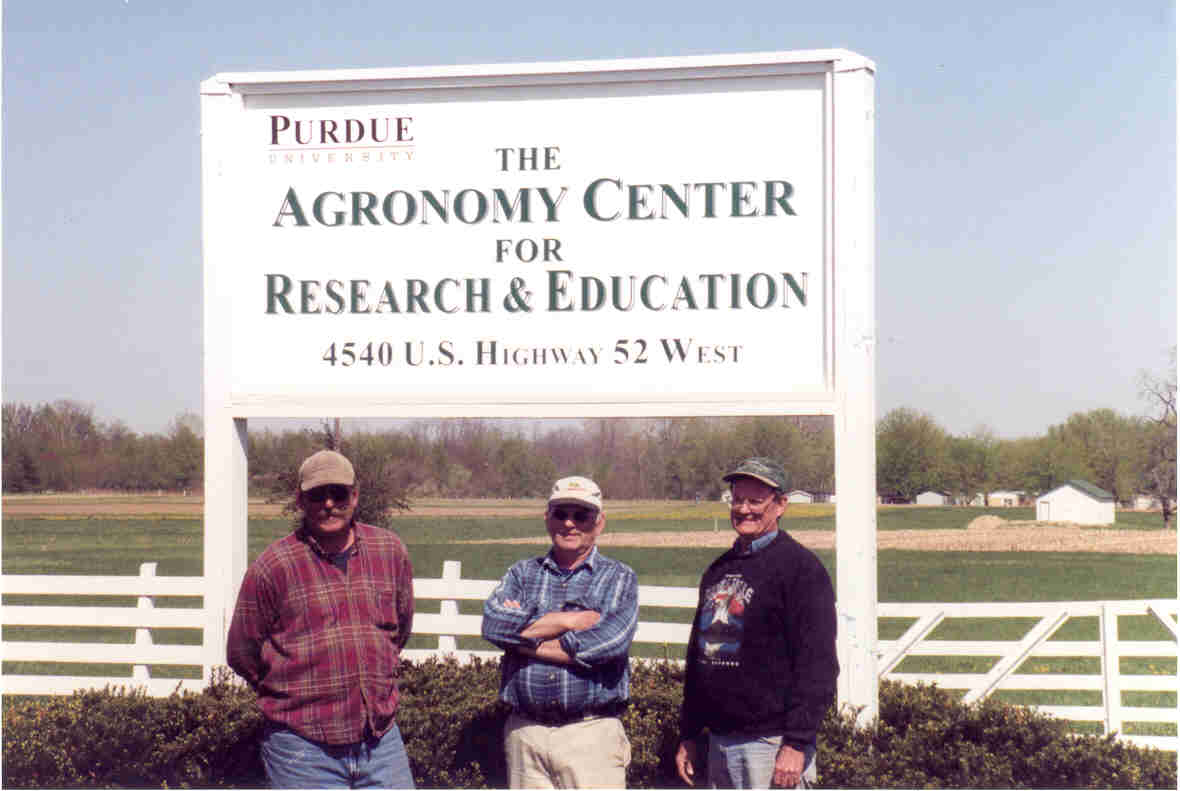History of the Farm

The Beginnings of the Agronomy Farm
By Jim Beaty and Ozzie Luetkemeier
Supplemental updates by Marcus Mues
The Agronomy Center for Research and Education (ACRE) has had a few names over the years. In the ’90s it was called “the Agronomy Research Center,” and before that it was the “Agronomy Farm.” Today, many people still tell the main office they are going to “the farm” and the location is understood.
But it wasn’t always that way. Prior to the 1950s the Agronomy Department operated multiple farms including the Soils and Crops Farm, Sand Farm at Culver, North Vernon Experimental Field, Pinney Purdue Experimental Field, and Southwestern Indiana Wheat Program.
In 1949 the department purchased the new “Agronomy Farm,” now known as the Agronomy Center for Research Education (ACRE). The property came with two old houses and several old farm buildings, including a large, orange horse barn. The farm was well known locally.
Before the department bought it, the land belonged to Edwin G. Lyman of the Lyman Coal Co. in Lafayette. Ryan Dykstra, the company’s president, lived in the old house and the Agronomy Department had to find him housing before the land was transferred.
The trademark sugar maple trees along the lane were planted around the 1900s by Louise Chase and some of her 13 children. Her husband was Frank Chase, the Lyman farm manager from the 1890s to the 1920s. The farm became known as the “Maple Avenue Stock Farm.”
Oscar W. “Ozzie” Luetkemeier, was the Agronomy Farm’s first superintendent, beginning in 1949.
“I was new and green, just out of Agronomy graduate school,” Ozzie said. “I had a relatively new, pregnant wife. I felt mighty lucky to receive the assignment to be the Agronomy Farm Superintendent.” He was Superintendent until 1986. Ozzie and his wife Louise raised three boys while living on the Agronomy Farm.
Ozzie’s job was to make a 374-acre general farm a research station and to phase out of the Soils and Crops Farm. His first staff included three “near retirement” employees: Bill Riley, Ed Foster, and Billy Feldmeyer. The faculty member in charge of the old farm was Robert R. Mulvey. Between them, the four men had 117 years of experience. S.R. Miles was responsible for mapping the new developing farm, including the location of the markers and field tile, which Jim Beaty, the farm’s second superintendent, continued to use and protect.
When J.B. Peterson and the Agronomy Department decided to relocate to the new Agronomy Farm, they decided to leave the team of horses, Kate and Jane, at the Soils and Crops Farm for use until field research was finalized there in 1952. After that, the horses were sold and the John Deere “A” came to the Agronomy Farm. Bill Riley stayed at the old farm too and retired in 1952.
Among Ozzie’s first priorities at the new Agronomy Farm was working with Mulvey and the organizing committees to design the experimental field layouts and drainage, place permanent field markers, build roads, move and bury the rocks, find and develop a source of water, design and build the farm buildings, develop operating policies, and transition into the new field experiments. In 1950, N. J. Volk, the AES Director, bought an old Buckeye Tiling Machine, rented it to Agronomy, and hired John Royer to operate it.
In May 1950, Peterson disbanded the transition committees and appointed the first Agronomy Farm Committee. He placed these people in charge of various responsibilities: Herb H. Kramer, crop research; Kenny T. Payne, buildings; Stanley A. Barber, soil research; Mulvey, land development; Miles, land use; and Luetkemeier, operations.
Payne was placed in charge of new farm buildings and by 1953 we were on our way to building three block buildings and three metal pre-fabricated buildings (from United Steel in Wooster, Ohio). The faculty and graduate students, with the help of Jimmy Martin and the farm crew, actually built the metal buildings.
Ed Foster, the first Shop Foreman, retired in 1952 and was replaced by Jimmy Martin. Jimmy had already been placed in charge of day-to-day building construction supervision since 1950. Other Shop Foremen to follow were Lamar Biggs, Jeff Fields, and currently Steve “Zach” Zachariah. Russell Seal was the Field Research Foreman for a while. Several good people have worked as field technicians since 1949, including Bill Garner, Steve Jones, and Brad Wetli.
To add land to the original 374 acres, the Agronomy Department borrowed money from the Biochemistry Department in the mid-1950s to purchase the adjacent 100-acre Mennen Tract. It was originally bulk farmed to corn to pay off the debt and interest.
More land was added later: the 240-acre Baker Tract in the 1970s, the 237-acre Welch Tract in the 1980s, the 40-acre Erwin tract in the 1990s, and The Oaks property in 2005. The Peterson Prairie Plot was established in 2003, named in honor of J.B. Peterson.
In April of 2021, Rachel Stevens was appointed as the new farm manager. Together with her team of research technicians - Aaron Kult, Bryan Gretencord and Evan Bossung - she ensures that operations at ACRE continue to thrive.
